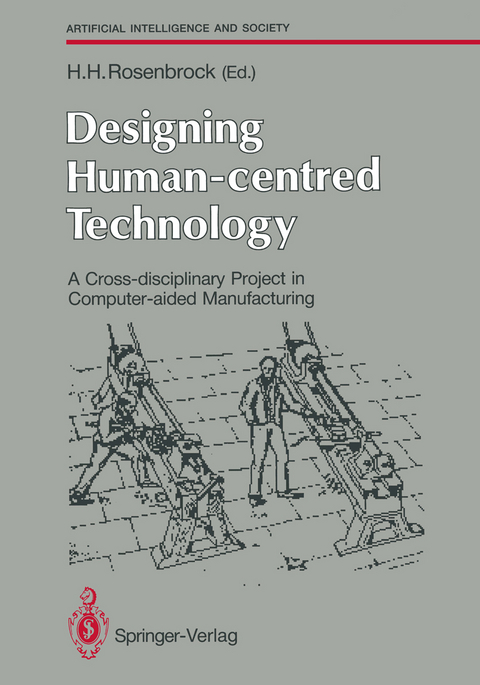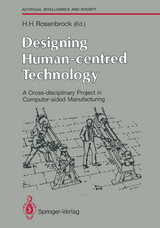Designing Human-centred Technology
Springer Berlin (Verlag)
978-3-540-19567-2 (ISBN)
1. The Background to the Project.- Why is Taylorism so Widespread?.- An Alternative Technology?.- The Steering Committee.- The Application for Funding.- Steering Committee Discussions.- Methodology.- The Aims of the Project.- 2. The Technical Problem.- Some History.- Numerical Control.- Record-Playback.- Cutting Technology.- Design.- Learning, but Learning What?.- My Own View.- Terminology.- 3. Towards a Design Methodology: A Psychologist's View.- The Design Context.- Design Criteria Related to the Human as a Component of the System.- Design Criteria Related to the System as the Operator's Environment.- Heuristics in Design Negotiation: The 'Blank Table Debate'.- Towards an Interactive Design Process.- Conclusion.- Appendix: Operator Control and Automation Howard Rosenbrock and Martin Corbett.- 4. The Social and Engineering Design of Computer Numerically Controlled Technology.- Numerical Control Technology.- The Development of Cutting Technology Software.- The 'Blank Table Debate' - A Divergence of Opinion.- Conclusions and Personal Reflections - The Engineer as a Social Scientist.- 5. A Computer Science View.- Software Structure.- Aspects of the UMIST System.- Software Development.- Use of Alternative Programming Methods.- Conclusion.- Appendix: Skeleton Syntax for Part-programs.- 6. On the Collaboration Between Social Scientists and Engineers.- Background - The Dynamics.- Models of Science.- Operational Issues.- Making It Happen - Institutions and Infrastructure.- 7. (How) Can Technology be Redirected? A Scandinavian Perspective.- The Concept of Non-subordinating Machinery.- Methodologies for Designing Redirected Technology.- Was the Project Appropriate and Efficacious in a Redirection Effort?.- Future Developments.- 8. A Works Director's View.-Evolution of New Technology and Human Skills.- The Operator, His Machine, and a Human-centred Approach to Technology.- The UMIST Project.- Conclusion.- 9. The Coordinator's View.- General Achievements.- The Conduct of the Project.- Cross-disciplinary Work by Engineers and Social Scientists.- The Importance of Management and of Technical Process Development in Human-centred Working.- The Future.- Final Comment.- 10. Human-centred Systems.- The Early Stages.- Technology, Science and Ideology.- Proposals for a New Approach.- First Practical Moves.- Issues of Status, Skill and Uncertainty.- Human-centred Capabilities.- Future Development of Human-centredness.- 11. The ESPRIT Project.- and Summary.- The Meaning of Human-centredness.- The Factory of the Future.- ESPRIT Project 1217 (1199).- CIM Design Considerations.- The BITZ Demonstration Site.- The Shop-floor Monitor and Controller.- The Sketching Module.- The BICC Demonstration Site.- The Rolls Royce Demonstration Site.- The Human-centred Lathe Controller.- Concluding Remarks.- Appendix: Participating Organisations.- 12. Postscript.- Appendices.- 1. Short CVs of Contributors.- 2. SERC Application.- 3. Transcript of a Part of the Steering Committee Meeting Held on 12 July 1982.
| Erscheint lt. Verlag | 7.12.1989 |
|---|---|
| Reihe/Serie | Human-centred Systems |
| Zusatzinfo | XVI, 208 p. |
| Verlagsort | London |
| Sprache | englisch |
| Maße | 170 x 244 mm |
| Gewicht | 425 g |
| Themenwelt | Informatik ► Weitere Themen ► CAD-Programme |
| Technik ► Maschinenbau | |
| Schlagworte | Artifical Intelligence • Automation • CIM • Computer-aided Engineering • Computer-Aided Engineering (CAE) • Computer-aided manufacturing • Computer-Aided Manufacturing (CAM) • Computers and Society • Control • Engineering Economics • Evolution • Heuristics • Intelligence • learning • Manufacturing • programming • Sketch • sketching • Uncertainty |
| ISBN-10 | 3-540-19567-X / 354019567X |
| ISBN-13 | 978-3-540-19567-2 / 9783540195672 |
| Zustand | Neuware |
| Haben Sie eine Frage zum Produkt? |
aus dem Bereich




